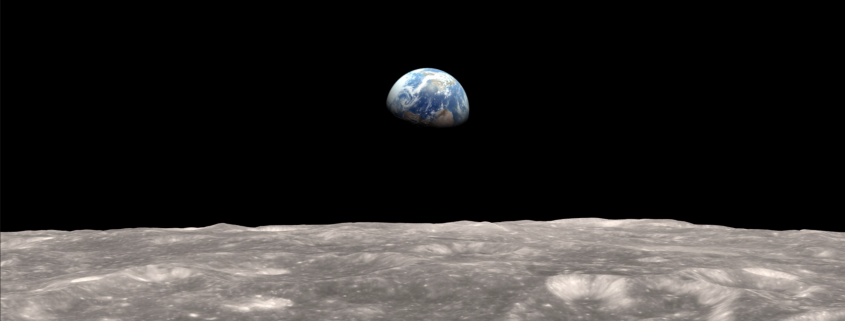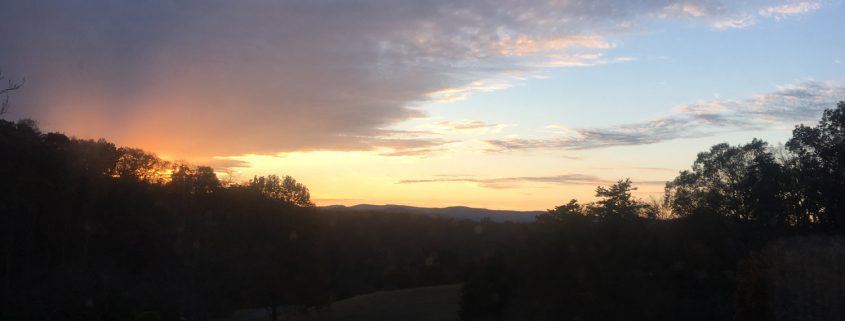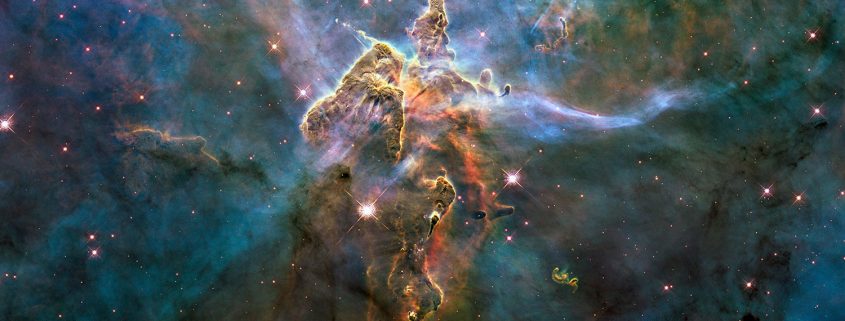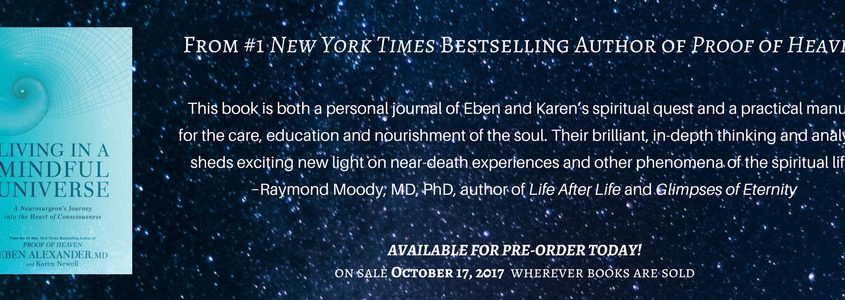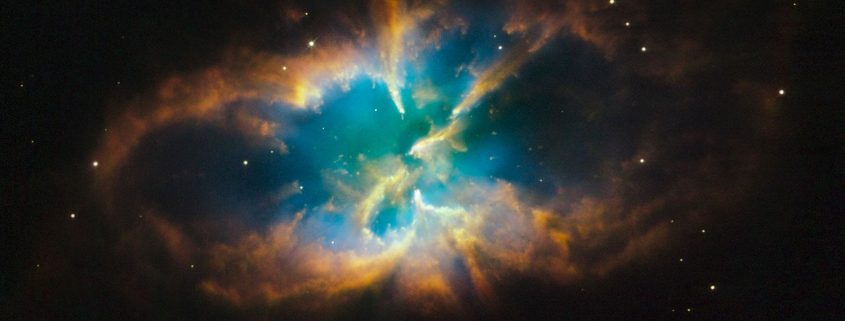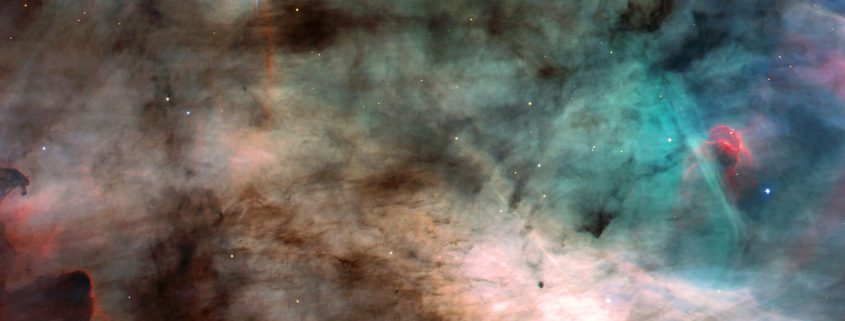Throughout my formative years, I avidly followed the space program starting in my first grade year in May 1961 when I watched Alan Shepard’s 15-minute suborbital Mercury flight. I became a huge fan of the space program and followed all of the Mercury, Gemini, and Apollo missions as if I were just another member of the crew, all the way through Apollo 17 when I was a senior in high school. Apollo 8 was a fantastic gift in 1968, when Jim Lovell, Frank Borman and Bill Anders orbited the moon on Christmas Eve and broadcast over their primitive black-and-white television camera a message of peace for all of humanity. But the holy grail clearly involved walking on the moon – and Apollo 11 owned that absolute distinction.
Fifty years ago, during the wee morning hours of the midsummer days of 1969, I read Arthur C. Clarke’s fantastic science fiction novel 2001: A Space Odyssey, usually reading in those early morning hours before going out around 4:30 am to deliver newspapers in the dawn twilight. Looking up at the starry heavens, my mind only half on the job of delivering newspapers, I mused over all of the advanced civilizations I imagined to be up in that velvety sky. My mind was completely captured by the implications of how going to the moon would change our collective human destiny.
In the days leading up to that historic moon landing, families would cluster around that first generation of television sets, watching intently as Walter Cronkite described the momentous occasion we were privileged to witness firsthand. The images were uncolored and fuzzy and the audio was filled with static, but the magic of bringing the moon’s surface to life intoxicated everyone. At 4:17pm EDT on Sunday July 20, 1969, the first humans expertly and precisely landed on the moon, announced by Armstrong: “Houston, Tranquility base here. The Eagle has landed.” The last-minute dodging of the boulder field can only be attributed to the human skill of proper piloting by Neil Armstrong with only 20 seconds of fuel to spare. Armstrong’s first steps on the moon occurred at 10:56pm that evening as 500 million people followed from planet Earth, hearing him proclaim for the ages, “One small step for man, one giant leap for mankind.” What an understatement!
This moment is arguably the greatest historical achievement of humanity to date – mankind’s first exploration of another heavenly body. Copernicus bravely defied the accepted viewpoint of his time and challenged the idea that we were the center of the universe by demonstrating that planets revolve around the sun. It’s easy now to look back and see that event as the initiation of the Scientific Revolution that led to our current amazing technological achievements. I believe that historians of say, 5,000 years in the future, will come to regard our first tentative spacefaring voyages off of planet earth to be of singular importance.In fact, some have suggested that the only name from our current epoch that will merit inclusion in the history books of the future will be that of Neil Armstrong – the first human being to step on a celestial body other than earth.
Many in my generation grew up believing our entire lives would be spent actively pursuing the spacefaring activities of a modern civilization. Those alive at the time will remember that the United States and the Russians were locked in a “Cold War,” and President Kennedy had set the agenda back in 1961, when he dedicated the United States to a program of flying men to the moon, and returning them safely to earth, before the end of the decade. Even today, we probably would have trouble scaling up the technical abilities in rockets and equipment at such a quick pace.
The early program was decidedly competitive, even military, in its nature. For both the Mercury and Gemini programs, men would ride capsules atop ballistic missiles designed mainly for hurling nuclear warheads around the world (the Redstone, Atlas and Titan rockets). Only when we graduated to the actual moon-focused Apollo missions did the astronauts ride atop rockets designed for this more peaceful purpose – the Saturn V. A most effective rocket it was, 363 feet tall, weighing 6.5 million pounds, its first stage burning 15 tons of liquid oxygen and refined kerosene every second, hurling the 310,000 pound third stage/command-service module/Lunar Excursion Module into earth orbit from which they then accelerated into a trans-lunar trajectory. If so tasked, the Saturn V was mighty enough to boost a many-ton payload off to one of the nearest stars, but the journey would take hundreds of thousands of years.
Mission planners knew the importance of the operation, especially its symbolic power: they chose Neil Armstrong, a civilian test pilot, and formerly a naval aviator during the Korean conflict to lead the mission. He had proved his mettle by flying the X15 rocket plane almost 4,000 mph at a peak altitude of 207,000 feet, and was selected over his fellow military astronauts to lead the Apollo 11 mission. By the time of the actual Apollo landings, a more peaceful goal than the military race with the Russians, one shared with all of humanity, was reflected in the language of the commemorative plaque they would leave at Tranquility Base – “We came in peace for all mankind.”
Armstrong had already witnessed harrowing escapes from death during his career as an astronaut. During the Gemini 8 mission in 1966, after successfully docking in orbit with the target Agena vehicle, their spacecraft went into an uncontrolled roll that became so fast that Armstrong and fellow astronaut David Scott came within seconds of blacking out before Armstrong was able to correct it. In May, 1968, while test piloting the Lunar Landing Research Vehicle, he ejected with less than a second to spare before the experimental craft slammed to the ground, exploding into a fireball, as Armstrong drifted gently to earth under his parachute a few feet away.
When the movie 2001: A Space Odyssey came out in 1968 and depicted a spaceship landing at a city on the moon, we all assumed that that was a reasonable version of our future – that we would be the ones inhabiting those lunar cities by the early 21st century. Alas, the fickle nature of the American public, as predicted by the mastermind behind the Saturn V, Werner von Braun, judged the brief adventures of the Apollo program to be sufficient for their desires, and dropped the ball on further manned exploration of space. Thankfully, we now appear to be getting back on track, not only for a return to the moon, but, more importantly, towards the goal of building a sustainable colony on the planet Mars.
I’ve had the distinct honor and privilege of meeting and talking with four of the highly skilled Apollo astronauts, including Neil Armstrong himself, as well as Frank Borman and Jim Lovell, both of whom flew to the moon on the moon-orbital mission of Apollo 8. Lovell also commanded the Apollo 13 mission, a harrowing journey in which the astronauts demonstrated the utmost skill in returning safely home after an explosion crippled their craft en route to the moon. I also met Edgar Mitchell, who served as the Lunar Excursion Module pilot accompanying Alan Shepard down to the Fra Mauro Highlands they hiked during the Apollo 14 mission in February, 1971.
One of the great joys of my life was having Edgar share his reflections on that monumental journey while I was a guest in his home in 2012 (more fully shared in my book Living in a Mindful Universe, co-written with Karen Newell, 2017). Edgar was so deeply affected by his experience during the Apollo 14 moon-landing mission, especially by a profound epiphany that occurred during the ride back to earth: He clearly saw the fundamental presence of consciousness throughout the universe while gazing out the window of Apollo 11’s command module returning from the moon. He came back to found the Institute of Noetic Sciences, which to this day carries out his bold mission to more fully explore the profound mystery of consciousness itself – a frontier beyond outer space.
Edgar realized how closely his life journey of elucidating the consciousness underlying the universe paralleled my own observations of the primacy of consciousness resulting from my near-death experience (NDE) due to severe bacterial meningitis in November 2008. Edgar shared my vision that the coming awakening of humanity to the true nature of consciousness would rival in importance the 16th century Copernican revolution that had moved man’s notion of the center of the universe from the earth to the sun. We are on the verge of another monumental scientific revolution – one that validates the notion that we are all in this together.
I recall how all of the astronauts shared similar observations about the fragility and undivided beauty of our earthly home. Their firsthand experiences make them kindred spirits with the NDE community I have come to know so well over the last decade — we all share the sense of oneness and connectedness with each other. Those Apollo astronauts all professed how seeing our lovely planet from space only heightened the sense that there are no boundaries of countries visible, that the entire beautiful planet is one we all share together. They also remarked on how fragile our atmosphere is, just the tiniest blue sliver, tenuously embraced by the lands and seas of our extraordinarily precious home planet.
One major impetus for pursuing space exploration is to serve as insurance against our own extinction. During the half century since the first moon landing, we have come to discover in increasingly alarming fashion that our addiction to burning fossil fuels might well render our planet uninhabitable in the next century or so due to the greenhouse gas effects of all of that carbon dioxide our modern civilization belches into the atmosphere. We must colonize other planets, if for no other reason than to survive if we are foolish enough to wreck our own home.
A grander overall vision for the importance of these spacefaring efforts is one of joining that much bigger club of sentient life throughout the cosmos, a vision that was quite clear to me during my coma journey. This grander vision of humanity as part of the interstellar community is one more consistent with the maturity of humanity suggested by the NDE community, where we bear responsibility for our choices and acknowledge at every step the importance of our choices for the higher good of all involved.
So, cherish the world’s reliving of the Apollo 11 moon landing a half century ago, and reflect on how such ventures tend to unify us, to fire our imaginations to engender the best future we can envision. We are truly all in this together, sharing this star-faring journey on the good earth, and we have the capacity as human beings to most fully enjoy this voyage through expressions of kindness, mercy and love towards our fellow travelers.
Those who want an in-depth, personal experience in reminiscing the Apollo 11 mission should go to https://apolloinrealtime.org/11/ to relive every second of the adventure.

